
Leaffooted bugs go through transformations as they mature

|
|
This is not a good bug to find in your vegetable
garden: It's a Leptoglossus zonatus , a leaffooted bug. (Photo: Debbie Arrington) |
Just when you think you can tell a good bug from a bad bug, Mother Nature throws you a curve.
Some bugs transform into several different forms – called instars – before they fully mature. They keep molting and going through various stages of metamorphosis until they become complete (and much more recognizable) adults.
Right now in Sacramento gardens, multiple generations of leaffooted bugs are scrambling over our tomatoes. They’re not only different ages, but different species, and some of those bad babies mimic good bugs.
The leaffooted bug, a stink bug cousin, gets its nickname from the leaflike extensions on its back legs. The nymphs generally stick together for protection. The adults can fly and are much more mobile.
A fellow gardener at Fremont Community Garden found one on his tomatoes, and wondered if it might be an assassin bug, which is a predatory insect and considered a garden good guy.
Usually, the leaffooted bugs we see at Fremont, located in Midtown Sacramento, have little zigzag stripes and they’re pretty big – over an inch tall. That’s Leptoglossus zonatus .

|
|
A
Leptoglossus occidentalis
, a type of leaf-
footed bug. (Photo courtesy Alan Moritz)
|
But it’s still a leaffooted bug, an immature Leptoglossus occidentalis . If you look closely, you can see the beginnings of those back “leaves.”
According to the UC Cooperative Extension pest notes, leaffooted bug populations tend to swell in late June and early July.
“Overwintering leaffooted bugs can lay over 200 eggs during a two-month period in the spring,” say the pest notes. “Nymphs emerge from the eggs about 1 week after being deposited, after which they develop into adults in 5 to 8 weeks.
"Adults are long-lived and can lay eggs over an extended period, so the population can consist of all life stages by late June. At this time, overwintering adults are still alive as the first generation of their offspring develop into adults.”
Throughout the summer, two to three generations of leaffooted bugs may be coexisting in the garden at the same time. And they’re all hungry. They go after tomatoes (in particular) but are a real pain on pomegranates, too, as well as a wide range of other fruits and vegetables.
The best way to combat them: Knock them off the plant into a pail or dishpan of water with 1 teaspoon dish soap (to break surface tension). They can’t swim and they’ll drown.
They tend to scramble sway from people, so slip the container under the tomatoes, then make motions from above or gently shake the vine’s trellis. The bugs will hop off the fruit – and right into the water. For pomegranates, gently shake the fruit over water; the baby bugs will fall out of the fruit’s blossom end.
For more on identifying and combating leaffooted bugs: http://ipm.ucanr.edu/PMG/PESTNOTES/pn74168.html
Comments
0 comments have been posted.Sacramento Digs Gardening to your inbox.
Food in My Back Yard Series
April 29: What's (already) wrong with my tomato plants?
April 22: Should you stock up on fertilizer? (Yes!)
April 15: Grow culinary herbs in containers
April 8: When to plant summer vegetables
April 1: Don't be fooled by these garden myths
March 25: Fertilizer tips: How to 'feed' your vegetables for healthy growth
March 18: Time to give vegetable seedlings some more space
March 11: Ways to win the fight against weeds
March 4: Potatoes from the garden
Feb. 25: Plant a fruit tree now -- for later
Feb. 18: How to squeeze more food into less space
Feb. 11: When to plant? Consider staggering your transplants
Feb. 4: Starting in seed starting
Sites We Like
Garden Checklist for week of April 27
Once the clouds clear, get to work. Spring growth is in high gear.
* Set out tomato, pepper and eggplant transplants.
* From seed, plant beans, beets, cantaloupes, carrots, corn, cucumbers, melons, pumpkins, radishes and squash. Plant onion sets.
* In the flower garden, plant seeds for asters, cosmos, celosia, marigolds, salvia, sunflowers and zinnias. Transplant petunias, zinnias, geraniums and other summer bloomers.
* Plant perennials and dahlia tubers for summer bloom. Late April is about the last chance to plant summer bulbs, such as gladiolus and tuberous begonias.
* Transplant lettuce and cabbage seedlings.
* Weed, weed, weed! Don’t let unwanted plants go to seed.
* April is the last chance to plant citrus trees such as dwarf orange, lemon and kumquat. These trees also look good in landscaping and provide fresh fruit in winter.
* Feed citrus trees with a low dose of balanced fertilizer (such as 10-10-10) during bloom to help set fruit. Keep an eye out for ants.
* Apply slow-release fertilizer to the lawn.
* Thoroughly clean debris from the bottom of outdoor ponds or fountains.
* Start thinning fruit that's formed on apple and stone fruit trees -- you'll get larger fruit at harvest (and avoid limb breakage) if some is thinned now. The UC recommendation is to thin fruit when it is about 3/4 of an inch in diameter. Peaches and nectarines should be thinned to about 6 inches apart; smaller fruit such as plums and pluots can be about 4 inches apart. Apricots can be left at 3 inches apart. Apples and pears should be thinned to one fruit per cluster of flowers, 6 to 8 inches apart.
* Azaleas and camellias looking a little yellow? If leaves are turning yellow between the veins, give them a boost with chelated iron.
* Trim dead flowers but not leaves from spring-flowering bulbs such as daffodils and tulips. Those leaves gather energy to create next year's flowers. Also, give the bulbs a fertilizer boost after bloom.
* Pinch chrysanthemums back to 12 inches for fall flowers. Cut old stems to the ground.
* Mulch around plants to conserve moisture and control weeds.